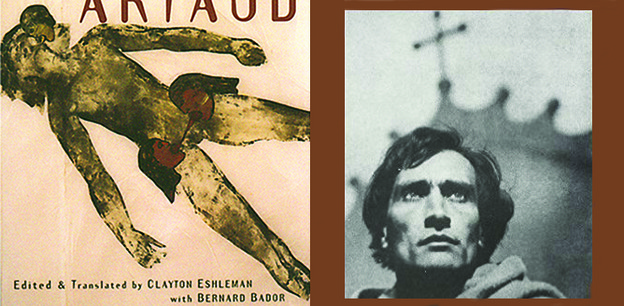Antonin Artaud's 'Hyper-Negation'

When I asked the poet David Abel what first drew him to Antonin Artaud’s work, he said, “At least one dimension of that work is a grand negation. A gigantic no, which at a certain time in my life was absolutely thrilling. […] I feel like ‘no’ is a landscape that now is very rich and three-dimensional. And what I got from Artaud is foundational, a part of the architecture or a part of the geology of the no, but which now has lots of other structures in it.”[1] David Abel’s response captures a fundamental celebration of Antonin Artaud’s writings. Artaud refused, on principle, many accepted aspects of society and art which he found oppressive. He refused, for example, to “polish” his poems “to the utmost perfection,” and instead let the “faltering” and “impurities” signal the “true wastage” that came over him when “thought abandon[ed]” him.[2]
Artaud refused the unified style of writing common in his time, and he also rejected writing itself—even as he wielded his pen. The quote from Nancy Spero’s painting, “All Writing is Pigshit,” comes from “Nerve Scales,” an essay published in 1925 when Artaud was twenty-nine years old. In this essay he rails against writers in general and critics in particular, seething that “people who leave the realm of the obscure in order to define whatever is going on in their minds, are trash. The whole pack of literati are trash, particularly these days.”[3] He continues,
All those who fix landmarks in their minds, I mean in a certain part of their heads, in strictly localised areas of their brains, all those who are masters of their own language, all those for whom words mean something, all those for whom there are currents of thought and who think the soul can be sublime; those who are the spirit of the times, and who have named these currents of thought I am thinking of their specific tasks and the mechanical creaking their minds give out at every gust of wind,
— are trash.[4]
He doesn’t want his contradictions to be ironed out; his writing doesn’t flow from him like wind; he doesn’t want to pull and straighten his intestinal cry into a linear, untroubled narrative. Instead, Artaud wants to represent the way his mind works. This essay, “Nerve Scales,” sketches the shape of his thinking — its pattern. Its dynamic structure. Thought, he recounts, “slips away snake-like.”[5] Artaud explains that
all the terms I choose to think with are TERMS for me in the proper sense of the word, true endings, bordering my mental ( )[6] and all the states of mind to which I have subjected my thoughts. I am truly LOCALISED by my terms and if I say I am LOCALISED by my terms, it means I do not acknowledge them as valid in my thought. I am really paralysed by my terms, by a succession of endings.[7]
Artaud describes a process akin to writer’s block, but much more ominous. The gaps or blockages in his thinking are a part of his mental illness — what he calls “a fearful mental disease.”[8] This fragmented pattern gets reflected in his poems. The poem “Cry,” published in 1925, begins
The little celestial poet
Opens the shutters of his heart,
The skies collide. Lethe
Uproots the symphony.[9]
Here, in some of his earliest work, Artaud introduces the idea of doubling. The skies are multiple; the poet is simultaneously within the sky, of the sky, and he collides with the sky. He is both contents and container. Or rather, the sky collides with what’s inside the celestial poet’s heart. The external sky crashes into his internal sky. Whatever lyric is left becomes uprooted, ungrounded, dislocated by oblivion. Artaud’s work documents his own void. His work is a hyper-negation. It's full of paradox and contradiction because he’s attempting to communicate what cannot be put into words. The abyss is a negative property.
Because Artaud often wrote about himself, his own abyss, I’ll spend some time in the next few posts detailing the major events in his life. Much like the contradictions in his work — or perhaps, in some respects, as a result of them — there are many contradictions in biographical accounts. For example, Bettina Knapp asserts that Euphrasie Nalpas, Antonin’s mother, was of Greek origin and came from Turkey, while Antoine-Roi Artaud, Antonin’s father, was “of French Provençal stock.”[10] On the other hand, in his introduction to Watchfiends & Rack Screams, Clayton Eshleman states that Antonin’s parents were cousins, an assertion supported by Julia Costich and Martin Esslin. Eshleman suggests the fact that Antonin's grandmothers were sisters may have some bearing on the early death of many of Antonin's siblings and on his own mental and physical ailments.[11] Where possible, and when I wasn’t able to confirm one or the other conflicting detail, I’ll provide endnotes that give the alternate account(s).
1. David Abel, Personal Interview, March 2, 2016.
2. Antonin Artaud, Collected Works Volume One, translated by Victor Corti, “Correspondence with Jacques Rivière,” (London: John Calder, Ltd., 1969), 27-30.
3. Artaud tr. Corti, “Nerve Scales,” 75.
4. Artaud tr. Corti, “Nerve Scales,” 75.
5. Artaud tr. Corti, “Nerve Scales,” 74.
6. word missing in the original
7. Artaud tr. Corti, “Nerve Scales,” 73.
8. Artaud tr. Corti, “Antonin Artaud to Jacques Rivière,” 27.
9. Artaud tr. Corti, “Antonin Artaud to Jacques Rivière, 33.
The original:
Le petit poète céleste
Ouvre les volets de son cœur.
Les cieux s’entrechoquent. L’oubli
Déracine la symphonie.
10. Bettina Knapp, Antonin Artaud: Man of Vision, (Chicago, Swallow Press: 1969), 3.
11. Clayton Eshleman, “Introduction,” Watchfiends and Rack Screams: Works from the Final Period by Antonin Artaud, Tr. Clayton Eshleman and Bernard Bador, (Boston: Exact Change, 1995), 1.
Language and its double